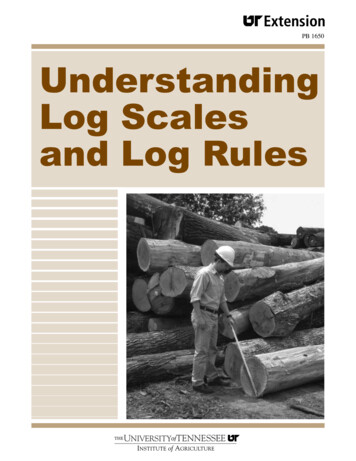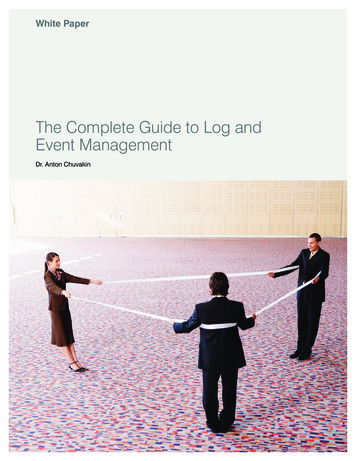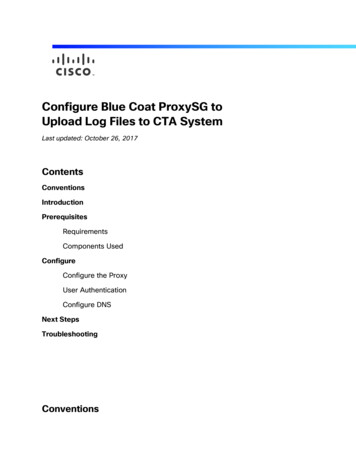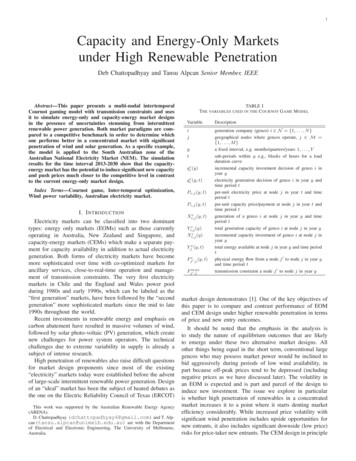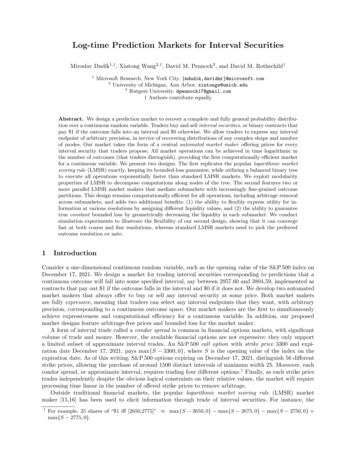
Transcription
Log-time Prediction Markets for Interval SecuritiesMiroslav Dudı́k1,† , Xintong Wang2,† , David M. Pennock3 , and David M. Rothschild11Microsoft Research, New York City. {mdudik,davidmr}@microsoft.com2University of Michigan, Ann Arbor. xintongw@umich.edu3Rutgers University. dpennock17@gmail.com† Authors contribute equallyAbstract. We design a prediction market to recover a complete and fully general probability distribution over a continuous random variable. Traders buy and sell interval securities, or binary contracts thatpay 1 if the outcome falls into an interval and 0 otherwise. We allow traders to express any intervalendpoint of arbitrary precision, in service of recovering distributions of any complex shape and numberof modes. Our market takes the form of a central automated market maker offering prices for everyinterval security that traders propose. All market operations can be achieved in time logarithmic inthe number of outcomes (that traders distinguish), providing the first computationally efficient marketfor a continuous variable. We present two designs. The first replicates the popular logarithmic marketscoring rule (LMSR) exactly, keeping its bounded-loss guarantee, while utilizing a balanced binary treeto execute all operations exponentially faster than standard LMSR markets. We exploit modularityproperties of LMSR to decompose computations along nodes of the tree. The second features two ormore parallel LMSR market makers that mediate submarkets with increasingly fine-grained outcomepartitions. This design remains computationally efficient for all operations, including arbitrage removalacross submarkets, and adds two additional benefits: (1) the ability to flexibly express utility for information at various resolutions by assigning different liquidity values, and (2) the ability to guaranteetrue constant bounded loss by geometrically decreasing the liquidity in each submarket. We conductsimulation experiments to illustrate the flexibility of our second design, showing that it can convergefast at both coarse and fine resolutions, whereas standard LMSR markets need to pick the preferredoutcome resolution ex ante.1IntroductionConsider a one-dimensional continuous random variable, such as the opening value of the S&P 500 index onDecember 17, 2021. We design a market for trading interval securities corresponding to predictions that acontinuous outcome will fall into some specified interval, say between 2957.60 and 3804.59, implemented ascontracts that pay out 1 if the outcome falls in the interval and 0 if it does not. We develop two automatedmarket makers that always offer to buy or sell any interval security at some price. Both market makersare fully expressive, meaning that traders can select any interval endpoints that they want, with arbitraryprecision, corresponding to a continuous outcome space. Our market makers are the first to simultaneouslyachieve expressiveness and computational efficiency for a continuous variable. In addition, our proposedmarket designs feature arbitrage-free prices and bounded loss for the market maker.A form of interval trade called a condor spread is common in financial options markets, with significantvolume of trade and money. However, the available financial options are not expressive: they only supporta limited subset of approximate interval trades. An S&P 500 call option with strike price 3300 and expiration date December 17, 2021, pays max{S 3300, 0}, where S is the opening value of the index on theexpiration date. As of this writing, S&P 500 options expiring on December 17, 2021, distinguish 56 differentstrike prices, allowing the purchase of around 1500 distinct intervals of minimum width 25. Moreover, eachcondor spread, or approximate interval, requires trading four different options.1 Finally, as each strike pricetrades independently despite the obvious logical constraints on their relative values, the market will requireprocessing time linear in the number of offered strike prices to remove arbitrage.Outside traditional financial markets, the popular logarithmic market scoring rule (LMSR) marketmaker [15,16] has been used to elicit information through trade of interval securities. For instance, the1For example, 25 shares of “ 1 iff [2650,2775]” max{S 2650, 0} max{S 2675, 0} max{S 2750, 0} max{S 2775, 0}.
Gates Hillman Prediction Market at Carnegie Mellon University operated LMSR on 365 outcomes, representing 365 days of one year, to forecast the opening time of the new computer science building [21]. Traderscould bet on different intervals by choosing a start and an end date. A similar market2 was later launched atthe University of Texas at Austin, using a liquidity-sensitive variation of LMSR [20]. Moreover, LMSR hasbeen deployed to predict product-sales levels [23], instructor ratings [4], and political events [14].LMSR has two limitations that prevent its scaling to markets with a continuous outcome space. First,LMSR’s worst-case loss can grow unbounded if traders select intervals with prior probability approaching zero[12]. Second, and crucially, standard implementations of LMSR operations run in time linear in the number ofoutcomes, or the number of distinct future values traders define—in our case, arbitrarily many. The constantlog-utility market maker [8] and other barrier-function-based market makers [22] feature constant boundedloss and so avoid the former problem, but still suffer the latter regarding computational intractability. Thus,basic operations in previously studied and deployed markets feature a relatively small set of predeterminedinterval securities and run in time linear in the number of supported outcomes, limiting the ability toaggregate high-precision trades and elicit the full distribution of a continuous random variable.In this paper, we develop two new market makers that both operate exponentially faster than LMSR andprevious designs. Market operations can be run in time logarithmic in the number of distinct intervals traded,or linear in the number of bits describing the outcome space (e.g., 64 bits if the outcome is represented asIEEE 754 double). In addition to computational efficiency, our market makers update online in such a waythat their worst-case loss, even against adversarial trades and outcomes, is bounded.Our first market maker calculates LMSR prices exactly, but does so exponentially faster by using abalanced binary tree data structure to efficiently implement interval queries and trades. The special formof the LMSR cost function permits its normalization constant—a key LMSR quantity—to be computed viaonly local computations on the balanced tree. Our work here contributes to the rich literature that showshow to overcome the worst-case #P-hardness of LMSR pricing [5] by exploiting the outcome space structureand limiting expressivity [6,13,7,24,18].To maximize predictive accuracy for a given level of subsidy, if traders’ information is coarse, the LMSRoutcome space should be coarse, and if traders’ information is fine, the outcome space should be fine. Oursecond market maker splits liquidity across two or more layers of increasing fineness, allowing the market toautomatically match the coarseness of traders’ information. It can also maintain arbitrage-free prices, whileachieving a constant bounded loss that is independent of how infinitesimally small the traders’ intervalsbecome. In experiments, we show that the second market maker can get close to the “best of both worlds”displayed by coarse and fine LMSR markets, regardless of the traders’ information structure.Because both proposed market designs allow trading intervals at machine precision, they can elicit anyprobability distribution over the continuous random variable that can be practically encoded by a machine.Throughout this paper, we use the S&P 500 index value as a running example, since stock options area prevalent and relevant application, but our framework is generic and can handle any one-dimensionalcontinuous variable, for example: the number of coronavirus infections by the end of the year; the date whena vaccine will be released to market; the landfall point of a hurricane along a coastline; or the number oftickets sold in the first weekend of a new movie release.2Formal SettingWe first review cost-function-based market making [1,8], and then introduce interval markets.2.1Cost-function-based Market MakingLet Ω denote a finite set of outcomes, corresponding to mutually exclusive and exhaustive states of the world.We are interested in eliciting expectations of binary random variables φi : Ω {0, 1}, indexed by i I,which model the occurrence of various events, such as “S&P 500 will open between 2957.60 and 3804.59 onDecember 17, 2021 ”. Each variable φi is associated with a security that pays out φi (ω) when the outcomeω Ω occurs. Therefore, the random variable φi is also called the payoff function. Binary securities pay out 1 if the specified event occurs, and 0 otherwise. The vector (φi )i I is denoted φ. Traders trade bundlesδ R I of security with a central market maker, where positive entries in δ correspond to purchases, andnegative values the short sales. A trader holding a bundle δ receives a payoff of δ · φ(ω), when ω ch-corner-gates-building-prediction-market2
Following [1] and [8], we assume that the market maker determines security prices using a convex anddifferentiable potential function C : R I R, called a cost function. The state of the market is specified bya vector θ R I , listing the number of shares of each security sold by the market maker so far. A traderwishing to buy a bundle δ in the market state θ must pay C(θ δ) C(θ) to the market maker, afterwhich the new state becomes θ δ. Thus, the vector of instantaneous prices in the corresponding state θis p(θ) : C(θ). Its entries can be interpreted as the market’s collective estimates of E[φi ]: a trader canmake an expected profit by buying (at least a small amount of) the security i if she believes that E[φi ] islarger than the instantaneous price pi (θ) C(θ)/ θi , and by selling if she believes the opposite. Therefore,risk neutral traders with sufficient budgets maximize their expected profits by moving the price vector tomatch their expectation of φ. Any expected payoff must lie in the convex hull of the set {φ(ω)}ω Ω , whichwe denote M and call a coherent price space with its elements referred to as coherent price vectors.We assume that the cost function satisfies two standard properties: no arbitrage and bounded loss. Theno arbitrage property requires that as long as all outcomes ω are possible, there be no market transactionswith a guaranteed profit for a trader. In this paper, we use the fact that C is arbitrage-free if and onlyif it yields price vectors p(θ) that are always coherent [1]. The boundedloss property is defined in termsof the worst-case loss of a market maker, supθ R I supω Ω θ · φ(ω) C(θ) C(0) , meaning the largestpossible difference, across all possible trading sequences and outcomes, between the amount that the marketmaker has to pay the traders (once the outcome is realized) and the amount that the market maker hascollected (when securities were traded). The bounded loss property requires that this worst-case loss be apriori bounded by a constant.2.2Complete Markets and Logarithmic Market Scoring Rule (LMSR)In a complete market, we have I Ω and securities are indicators of individual outcomes, φi (ω) 1{ω i},where 1{·} denotes the binary indicator, equal to 1 if true and 0 if false. For instance, to set up a completemarket for the S&P 500 opening price on December 17, 2021, we define ω as the price rounded to the nearestcent and capped at 5000, meaning that larger prices are treated as 5000. The resulting complete marketis defined by I Ω {0, 0.01, . . . , 4999.99, 5000}. We denote each market security as φω . A risk-neutraltrader is incentivized to move the price of each security φω to her estimate of E[φω ] P[ω], that is, to hersubjective probability of ω occurring. Thus, traders can express arbitrary probability distributions over Ω.Throughout the paper, we use variants of logarithmic market scoring rule (LMSR) [15], which is a costfunction for a complete market. LMSR has the cost function and prices of the form!Xeθω /bθω /b,(1)C(θ) b loge,pω (θ) C(θ)/ θω Pθν /bν Ω eω Ωwhere b is the liquidity parameter, controlling how fast the price moves in response to trading. It is shownthat b also controls the worst-case loss of the market maker, which equals b log Ω [15].The securities in a complete market can be used to express bets on any event E. Specifically, one share ofa security for the event E can be represented by the indicator bundle 1E RΩ with entries 1E,ω 1{ω E}.We refer to this bundle as the bundle security for event E to highlight the fact that it pays out 0 or 1depending on whether E occurs, but it is not one of the market securities φω . The immediate price of thebundle 1E in the state θ is thenPXeθω /b(2)pE (θ) : 1E · p(θ) pω (θ) Pω E θ /b .νν Ω eω EThe cost of buying the bundle s1E , sometimes referred to as “s shares of 1E ”, is a function of pE (θ) and s: !XXXθ/b(θ s)/bθ/b b logC(θ s1E ) C(θ) b log eω e ωeωω6 Eω E ω Ω b log pE c (θ) es/b pE (θ) b log 1 pE (θ) es/b pE (θ) .(3)Above, we write E c for the complementary event E c Ω\E, and use the fact pE (θ) pE c (θ) 1, whichfollows immediately from Eq. (2).3
2.3Interval Securities over [0, 1)We consider betting on outcomes within an interval [0, 1). Our approach generalizes to settings in which theoutcomes are in [α, β) for any [α, β) [ , ), by applying any increasing transformation F : [α, β) [0, 1)and then running the market on [0, 1). We assume that the outcome ω is specified with K bits, meaningthat there are N 2K outcomes with Ω {j/N : j {0, 1, . . . , N 1}}. For instance, to represent theS&P 500 example, we set N 219 524,288 and define the transformed outcome ω ω 0 /N , where ω 0 isthe S&P 500 price in cents. We can now cap the S&P 500 price at 5242.87 instead of 5000. At the end ofSections 3 and 4, we discuss how the assumption of pre-specified bit precision can be removed.In the outcome space Ω, we would like to enable the price and cost queries as well as buying and sellingof bundle securities for the interval events I [α, β) for any α, β Ω {1}.3 For cost-based markets, selltransactions are equivalent to buying a negative amount of shares, so we only seek to design algorithmsfor three operations: price(I), cost(I, s), and buy(I, s), where I is the interval event and s the number ofshares. A naive implementation of price and cost queries following Eqs. (2) and (3) would be linear in N .Here we seek to implement these operations in time that is logarithmic in N , i.e., linear in K log N .3A Log-time LMSR Market MakerWe design a data structure, referred to as an LMSR tree, which resembles an interval tree [9, Section 15.3]but includes additional annotations to support LMSR calculations. We first define the LMSR tree, and showthat it can facilitate market operations in time logarithmic in the number of intervals that traders define.3.1An LMSR Tree for [0, 1)We represent an LMSR tree T with a full binary tree, where each node z has either no children (when zis a leaf) or exactly two children, denoted left(z) and right(z) (when z is an inner node). We denote theroot node as root and the parent of any non-root node as par(z). Each node z is associated with an intervalIz [αz , βz ) that follows the tree hierarchy: the root is associated with the full interval Iroot [0, 1), andchildren of a node z hold intervals that partition Iz [αz , βz ) into adjacent intervals, i.e., Ileft(z) [αz , γz )and Iright(z) [γz , βz ) for some γz (αz , βz ). We refer to this structural property as the binary-searchproperty. It helps to find the unique leaf containing any ω Ω by descending from root and choosing left orright in each node based on whether ω γz or ω γz .To achieve log-time market operations, we keep track of the height of each node z, defined as the lengthof the longest path from z to any leaf. In this paper, we adopt an AVL tree [3] at the basis of our LMSR tree,but other balanced binary-search trees could also be used, such as red-black trees or splay trees. The nodeheights, denoted hz , are used to maintain the height-balance property of AVL trees: in each inner node z,we have hleft(z) hright(z) 1. This property ensures that the path length from root to any leaf is at mostO(log n), where n is the number of leaves of the tree [17].To facilitate LMSR computations, we maintain a scalar quantity sz R for each node z, which recordsthe number of bundle securities associated with Iz sold by the market maker. Therefore, the market staterepresented by an LMSR tree T isXθ(T ) sz 1Iz ,(4)z Tand we can further obtain the components of θ(T ) for each individual outcome ω as follows4 :XXθω (T ) sz 1Iz ,ω sz .The normalization constant in the LMSR price expression (Eq. 2) is thenXX PX Yeθω /b e ω z sz /b esz /b .ω Ω34(5)z3ωz T(6)ω Ω z3ωω ΩThroughout the paper, we operate in the outcome space discretized to events ω Ω specified with K bits, butwould like to indeed discuss interval events [a, b) that include reals of arbitrary precisions. Since, in measure theory,events are subsets of the outcome space, what we mean here are events of form [a, b) Ω.To facilitate presentation, we write ω z to mean ω Iz , and z 0 z to mean Iz0 Iz . Thus, z 0 z correspondsto z 0 being a descendant of z in T , and z 0 z corresponds to z 0 being a strict descendant of z.4
We decompose the above normalization constant computation along the nodes of an LMSR tree, by defininga partial normalization constant Sz in each node5 :Y1 XSz : esz0 /b .(7)N00ω zz : z z 3ωIt enables the following key recursive relationship, which is at the core of implementing price and buy:(esz /b · (βz αz )if z is a leaf, (8)Sz esz /b · Sleft(z) Sright(z)otherwise.Combining the above annotations and properties, we formally define an LMSR tree as follows.Definition 1. An LMSR tree is a full binary tree, where each node z is annotated with Iz [αz , βz ), hz ,sz , and Sz , where αz , βz Ω {1}, hz 0, sz R, and Sz 0, which satisfy: Binary-search property: Iroot [0, 1), and for every inner node z,αz αleft(z) βleft(z) αright(z) βright(z) βz . Height balance: hz 0 for leaves, and for every inner node z,hz 1 max{hleft(z) , hright(z) }, hleft(z) hright(z) 1. Partial-normalization correctness: Sz esz /b · (βz αz ) for leaves, and for every inner node z, Sz esz /b · Sleft(z) Sright(z) .Based on the LMSR tree construction, we implement the following operations for any interval I [α, β): price(I, T ): return the price of bundle security for I; cost(I, s, T ): return the cost of s shares of bundle security for I; buy(I, s, T ): update T to reflect the purchase of s shares of bundle security for I.In order to implement cost, it suffices to implement price by Eq. (3). Since the price of [α, β) can be obtainedfrom prices for [α, 1) and [β, 1), i.e., p[α,β) (θ) p[α,1) (θ) p[β,1) (θ), we focus on implementing price forintervals of the form [α, 1). Similarly, buying s shares of [α, β) is equivalent to first buying s shares of [α, 1)and then buying ( s) shares of [β, 1), as in both cases we end up in the same market state θ s1[α,β) . Thus,we implement price and buy for one-sided intervals I [α, 1), and all the remaining operations will follow.3.2Price QueriesWe consider price queries for I [α, 1). Let vals(T ) {αz : z T } denote the set of distinct left endpointsin the tree nodes. We start by assuming that α vals(T ), and will later relax this assumption. We proceedin two steps. First, we construct the set of nodes Z whose associated intervals Iz are disjoint and cover I.We construct Z by doing a binary search for α: as we go down the tree, we put in Z all of the unvisitedright children of the visited nodes, which have αz α, as well as the final node with αz α. Recall thatn is the number of leaves of the LMSR tree T ,Pand the height balance implies that Z has a cardinality ofO(log n). The resulting set Z satisfies pI (θ) z Z pIz (θ).Second, we determine pIz (θ) for each of the nodes z Z. Starting from the LMSR price in Eq. (2), wetake advantage of the defined partial normalization constants Sz and calculate pIz (θ) as follows:X111 X Y sz0 /bpIz (θ) eθω /b ·e(9)N Sroot ω zSroot N ω z 0z 3ω ! Y11 X Y(10) ·esz0 /b esz0 /b Sroot N ω z000z zz : z z 3ω!YSzsz0 /b e.(11)Srootz 0 z {z}Pz5The 1/N scale in Eq. (7) leads to a more natural interpretation of Sz , when z is a leaf (in the recursive relationship).5
In Eq. (9), we expand θω using Eq. (5). In Eq. (10), we use the fact that any node z 0 with a non-emptyintersection with z, i.e., Iz Iz0 6 , must be either a descendant or an ancestor of z (as a direct consequenceof the binary-search property). The product Pz in Eq. (11) iterates over z 0 on the path from root to z. Sincethe node z is found by following a binary-search path from the root, we can calculate Pz along the way.We now handle the case when α 6 vals(T ). After we reach the final leaf z on the search path, we haveαz α βz . We conceptually create two children of z: z 0 and z 00 with Iz0 [αz , α) and Iz00 [α, βz ), and α· pIz (θ) by applying Eq. (2).include z 00 in Z. Since θω is constant across ω Iz , we obtain pIz00 (θ) ββzz αzSummarizing the foregoing procedures yields Algorithm 1, which simultaneously constructs the set Zand calculates the prices pIz (θ). Since it suffices to go down a single path and only perform constant-timecomputation in each node, the resulting algorithm runs in time O(log nvals ), where nvals denotes the numberof distinct values appeared as endpoints of intervals in all the executed transactions. We defer the proof ofTheorem 1, alongside all other proofs from this paper, to the appendix.Theorem 1. Algorithm 1 implements price(I, T ) in time O(log nvals ).Algorithm 1 Query price of an interval I [α, 1).Input: Interval I [α, 1) with α Ω.LMSR tree T , with nodes z annotated with Iz [αz , βz ), hz , sz and Sz .Output: Price of bundle security for I.1: Initialize z root, P 1, price 02: while αz 6 α and z is not a leaf do3:P P esz /b4:if α αright(z) then5:price price P Sright(z) /Sroot6:z left(z)7:else8:z right(z) α9: return price ββzz α· P Sz /Srootz3.3Buy TransactionsWe next show how to implement buy([α, 1), s, T ) in time O(log nvals ), while maintaining the LMSR treeproperties. The main challenge is to simultaneously maintain partial-normalization correctness and heightbalance. We address this by adapting standard AVL-tree rebalancing.We begin by considering the case α vals(T ). Similarly to Uprice queries, we conduct binary search forα to obtain the set of nodes Z that cover I [α, 1), i.e., I z Z Iz . We update the values of sz acrossz Z by adding s, and obtain T 0 that has the same structure as T , but with the updated share quantities(sz s if z Z0sz szotherwise.Thus, the resulting market state isXXXθ(T 0 ) s0z 1Iz sz 1Iz s1Iz θ(T ) s1I .z T 0z Tz ZIt remains to update the partial normalization constants Sz in the tree. Here we rely on the recursiverelationship defined in Eq. (8) to update the ancestors of the nodes z Z, all of which lie along the searchpath to α, and each update requires constant time.When α 6 vals(T ), we need to split the leaf z that contains α [αz , βz ) before adding shares to right(z).This may lead to the violation of the height-balance property of T . Similar to the AVL insertion algorithm [17,Section 6.2.3], we fix any imbalance by means of rotations, as we go back along the search path. Rotationsare operations that modify small portions of the tree, and at most two rotations are needed to rebalancethe tree [3]. We further show in Appendix A.2 Lemma 1 that in each rotation, only a constant number ofnodes will require updates to preserve the partial-normalization correctness. Algorithm 2 describes the fullbuy operation, which runs in time O(log nvals ) thanks to the height balance.6
Algorithm 2 Buy s shares of bundle security for an interval I [α, 1).Input: Quantity s R and an interval I [α, 1) with α Ω.LMSR tree T , with nodes z annotated with Iz [αz , βz ), hz , sz and Sz .Output: Tree T updated to reflect the purchase of s shares of bundle security for I.1: Define subroutines:NewLeaf(α0 , β0 ): return a new leaf node z withIz [α0 , β0 ), hz 0, sz 0, Sz (β0 α0 )ResetInnerNode(z): reset hz and Sz based on the children of z and the value sz :hz 1 max{hleft(z) , hright(z) }, Sz esz /b (Sleft(z) Sright(z) )AddShares(z, s): increase the number of shares held in z by s:sz sz s, Sz es/b ze z rootwhile αz 6 α and z is not a leaf do. add s shares to z Zif α αright(z) thenAddShares(right(z), s)z left(z)elsez right(z)if αz α then. split the leaf zleft(z) NewLeaf(αz , α), right(z) NewLeaf(α, βz )z right(z)AddShares(z, s)while z is not a root do. trace the path back to update Sz and restore height balancez par(z)if hleft(z) hright(z) 2 thenRotate z and possibly one of its children to restore height balance (details in Appendix A.2 Algorithms 5)ResetInnerNode(z)Theorem 2. Algorithm 2 implements buy(I, s, T ) in time O(log nvals ).Thus, we have shown that price, cost and buy operations can all be implemented in time O(log nvals ),which is bounded above by the log of the number of buy transactions O(log nbuy ) as well as the bit precisionof the outcome O(log N ) O(K).6 We note that none of the operations require the knowledge of K, sothe market in fact supports queries with arbitrary precision. However, the market precision does affect theworst-case loss bound for the market maker, which is O(log N ) O(K). In the next section, we present adifferent construction, which achieves a constant worst-case loss independent of the market precision, whilethe interval operations require time O(log N ) O(K), rather than O(log nvals ).4A Multi-resolution Linearly Constrained Market MakerThis section introduces our second contribution, a novel cost-function-based market maker, referred to as themulti-resolution linearly constrained market maker (multi-resolution LCMM). The multi-resolution LCMMis based on LMSR, but it enables more flexibility by assigning two or more parallel LMSRs with differentliquidity parameters to orchestrate submarkets that offer interval securities at different resolutions. Thus,the multi-resolution LCMM can flexibly interpolate between LMSRs at different resolutions and guaranteea constant worst-case loss in sum. However, running submarkets independently can create arbitrage opportunities, as any interval expressible in a coarser market can also be expressed in a finer one. To preventarbitrage, we design a matrix that imposes linear constraints to tie market prices among different levels andsupports the computationally efficient removal of any arbitrage opportunity. We define the multi-resolutionLCMM and its properties, and show that price, cost and buy can be implemented in time O(log N ).6Clearly, nvals 2nbuy with each buy transaction introducing at most two new endpoint values. The value of nvalsis also bounded above by N 1 since the interval endpoints are always in Ω {1}.7
4.1A Multi-resolution LCMM for [0, 1)A Multi-resolution Market A binary search tree remains at the core construction of our multi-resolutionmarket. Unlike a log-time LMSR that uses a dynamic tree, it builds upon a static one, where each level ofthe tree represents a submarket of intervals, forming a finer and finer partition of [0, 1). Before introducingthe formal setting, we give an example of a market that offers interval securities at two resolutions.Example 1. Two-level market for [0, 1). We consider two submarkets, indexed by Z1 {11, 12} and Z2 {21, 22, 23, 24}, which partition [0, 1) into interval events at two levels of coarseness: I2 : I21 0, 41 , I22 14 , 12 , I23 12 , 43 , I24 34 , 1 .I1 : I11 0, 21 , I12 12 , 1 ;Thus, the market provides Usix interval securities in total that are associated with their correspondingU interval events (i.e., I I1 I2 and I 6). We index the securities by z Z, where Z Z1 Z2 {11, 12, 21, 22, 23, 24}. Each security pays out φz (ω) 1{ω Iz }.tuExtending the example to multiple resolutions, we represent the initial independent submarkets with acomplete binary tree T of depth K, which corresponds to the bit precision of the outcome ω. Let Z denotethe set of nodes of T , and Zk for k {0, 1, . . . , K} the set of nodes at each level. Z0 contains the root nodeassociated with Iroot [0, 1), and each consecutive level contains the children of nodes from the previouslevel, which split their corresponding parent intervals exactly in half. Thus, level k forms a partition of [0, 1)into 2k intervals of size 2 k , and the final level ZK contains N 2K leaves.The multi-resolution market offers interval securities indexed by nodes, and their payoffs are definedby the corresponding intervals Iz , i.e., φz (ω) 1{ω Iz }. We partitionU the securities into submarketscorresponding to levels, i.e., Ik Zk for k K, where Ik 2k and I k K Ik . For each level, we definethe LMSR cost function Ck with a separate liquidity parameter bk 0:!Xθz /bkCk (θ k ) bk loge.z ZkA Linearly Constrained Market Maker Recall that φ : Ω R I is the payoff function, and θ R I is the market state vector. Following the multi-resolution market construction, Ik describes
Log-time Prediction Markets for Interval Securities Miroslav Dud k1 ;y, Xintong Wang2, David M. Pennock3, and David M. Rothschild1 1 Microsoft Research, New York City. fmdudik,davidmrg@microsoft.com 2 University of Michigan, Ann Arbor. xintongw@umich.edu 3 Rutgers University. dpennock17@gmai


